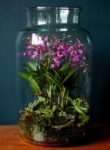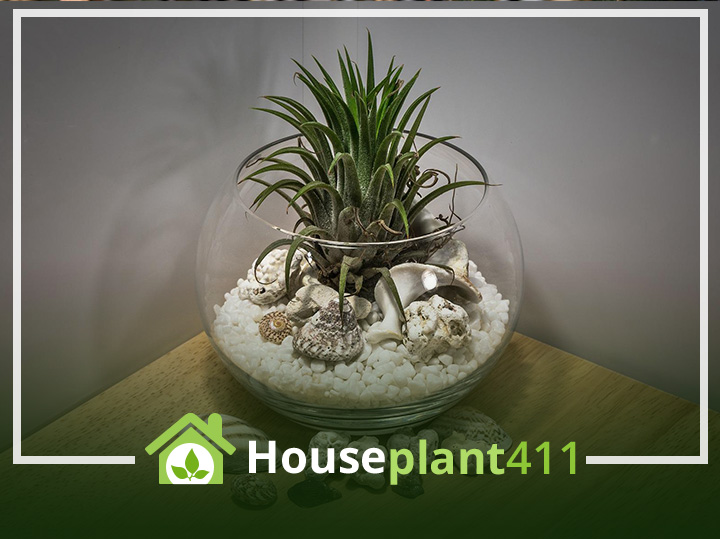A terrarium is a clear water- tight container that can hold soil, small plants, and decorative additions. It allows both heat and light to enter. Terraria (plural) can be open to the environment or sealed.
Use the open variety for succulent or semi- succulent plants (“dry plants”) that prefer dry air rather than high humidity. Some of the best plants for an open terrarium are air plants, echeveria, jade, kalanchoe, sedum, hawarthia, or small cacti. Plants that require bright direct light also do better in an open terrarium. Avoid using plants with a large root system.
Closed terrariums are mini ecosystems that create a humid environment by retaining much of their moisture. In fact you may have to open a sealed terrarium and wipe down the sides if too much humidity builds up inside. Excellent plants for a closed terrarium are: pilea, nerve plants, baby’s tears, spider wort, aluminum plants, mini begonias, mini orchids, button ferns, and creeping fig. Avoid using tall climbing plants and plants with a large root system.
When creating a terrarium, be sure to use plants that have the same lighting, watering, humidity, and feeding requirements. It’s a recipe for failure to put a succulent plant that needs very bright light, dry soil, and low humidity in with a fern that thrives on moist soil, high humidity, and medium light. Find care requirements for specific plants in the Popular Houseplants section of the website.

Plant Care
Light
The lighting for a terrarium depends upon the plants you decide to use. Succulent plants need very bright indirect light while other tropical plants will do well in medium light.
Water
Watering also depends on the plants you select; succulent plants need very dry soil while ferns like a moist soil. Since terrariums are closed or semi closed containers it takes the soil longer to dry out so be careful not to over water.
Fertilizer
Most terrariums need very little plant food since you don’t want the plants to get too large and outgrow their space. I recommend feeding twice a year with a fertilizer diluted to 1/4 the recommended strength.
Temperature
Without your realizing it, the temperature in a terrarium can get too hot for plants. Keep your terrarium away from heaters and never in afternoon sun. Lift the lid to cool down the terrarium.
Humidity
Lack of humidity is never a problem with a terrarium; on the other hand, too much humidity is often an issue. Open up the top of a terrarium container and wipe down the sides if condensation appears.
Flowering
The high humidity encourages plants like mini orchids and begonias to bloom often.
Pests
Check frequently for plant pests. If a plant is heavily infected, it should be immediately removed. As a preventative measure, I spray monthly with a weak solution of insecticidal soap.
Diseases
The high humidity inside a terrarium is very conducive to fungal and bacterial infections. Check the plants frequently and remove any dead leaves or infected plants immediately.
Soil
Proper drainage is essential or the roots of the plants stay too wet and the plant dies. First put in a 1/2 inch layer of pea gravel or aquarium grave. Next add 1/2 inch of horticultural gravel. You can add a layer of sphagnum moss is you want to prevent the next layer of soil from mixing into the charcoal and gravel. I tend not to because the moss often develops an unpleasant odor Then add about 2 inches (minimum) of a good potting soil rich in organic matter.
Pruning
Aggressively prune thin, straggly plants. Remove dead plants and leaves as soon as they appear.
Propagation
Use stem tip or leaf cuttings from plants that have grown too large to propagate new plants.
Special Occasion
Terrariums make great gifts, but be sure to include care instructions.
FAQ
Allow the soil to dry out before watering Succulent Plants in a terrarium. How often depends upon how much light and heat the terrarium gets?
The new pale leaves on your terrarium plants may me an indication that your terrarium needs more bright light. Try moving it to a brighter location and see if the problem improves.
It is very important to keep a terrarium clean and free of dead leaves and flowers. If a plant dies, immediately remove it and try to determine why it died.

